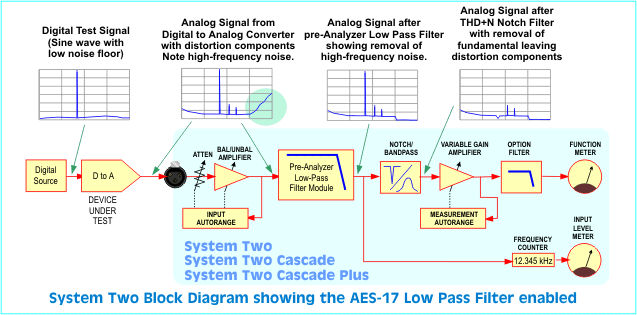

|
| |
|
S-AES17 Low Pass Filter | |
| S-AES17 is a hardware filtering kit for optional installation in System Two, System Two Cascade or Cascade Plus that satisfies the AES17-1998 specification for a standard low-pass filter for THD+N measurements of digital-to-analog converters (DACs) which exhibit high-level out-of-band noise. APWIN 2.20 and later versions support the use of this filter. The filter can be set to either of two bandwidth selections: 20kHz or 40kHz. The S-AES17 Low-Pass Filter Option improves upon the capabilities of the earlier S2-AES17LP filter, which is no longer available. | |
| S-AES17 SPECIFICATIONS | |
|
±0.10 dB,10 Hz–20.0 kHz |
|
±0.10 dB, 10 Hz–40.0 kHz |
|
>60 dB, 24.0 kHz–200 kHz |
|
>60 dB, 48.0 kHz–200 kHz |
|
|
|
<(0.0004 % [–108 dB] +1.0 µV) |
|
<(0.0003 % [–110.5 dB] +1.0 µV) |
|
|
|
<(0.0005 % [–106 dB] +1.4 µV) |
|
<(0.0004 % [–108 dB] +1.4 µV) |
| The figures below show the curve of the Audio Precision AES17 Low-Pass filter in the 20kHz mode. The orange lines indicate the AES17-1998 specification. For further information, refer to the AES17 Filter Description, Installation, and User's Guide. | ||||||
| ||||||
|
Background The Audio Engineering Society has defined the techniques for measuring digital audio equipment—that is, systems that contain digital to analog converters. AES17-1998 specifies the use of a "Standard low-pass filter" (section 4.2.1) that has a sharp roll off above the audio upper band, 20 kHz. The filter is specified to have a stop band attenuation of 60 dB or better above 24kHz, an aggressive slope. The filter must be inserted early in the measurement path in order to remove the out-of-band noise before the measurement notch filter and its subsequent gain. This will insure that the "+N" part of THD+N contains only the in-band noise and distortion. Without the filter, the automatic gain ranging that normally follows the THD+N notch filter can behave incorrectly and the resulting measurement will be in error. The Solution | ||||||
 | ||||||
Caveats
| ||||||